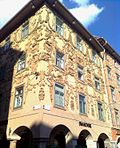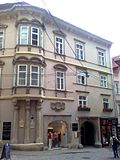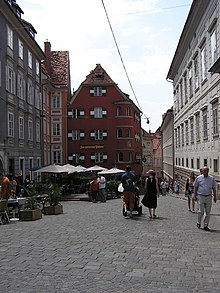Sporgasse
The Sporgasse is a street in the Innere Stadt district on the slope of the Schloßberg in Graz .
history
The street is older than Graz itself. The Strata Hungarica , a trade route between the Murtal and the Roman Pannonian provincial capital Colonia Claudia Savaria (today Szombathely in Hungary) ran here as early as Roman times . The name comes from the spur makers and armourers who lived here in the Middle Ages. The street name Sporergasse , first mentioned in 1346, was shortened to today's name Sporgasse around 1600 .
Today the Sporgasse is largely developed as a pedestrian zone and a busy shopping street. There is hardly any other street where you can read the architectural history of Graz as well as in Sporgasse. On the corner of the main square is the baroque Luegg-Haus with its mighty stucco facade and arcade. Immediately opposite is an Art Nouveau building with floral decorations, some in gold, and medallions with women's heads. A little further there is a baroque building, the large portal of which shows a riding image of St. John of Nepomuk .
The house with the former Strehly confectionery dates back to the 16th century. The confectionery dates back to 1596 and was therefore the oldest in Graz and Styria and one of the three oldest in Austria. Further up is the old Teutonic Knights' order , the inner courtyard of which is still paved with "Murnockerln" (stones from the Mur ), as was customary in the past. Opposite, behind the inconspicuous facade is a former Augustinian monastery, which is known today as the “ Stiegenkirche ”. At the upper end of the Sporgasse is one of the oldest inns in Graz, the "Goldene Pate", architecturally significant is the round bay window from the Renaissance period, which is unique for Graz. Opposite is the Palais Saurau with the "falling Turk", around whom some myths revolve.
List of important buildings
The list includes the house number that the building has, the proper name, notes on the history and architecture and a picture for illustration.
| House number | Proper name | Remarks | image |
|---|---|---|---|
| 2 | Luegg House | The core of the Luegg-Haus on the corner of Hauptplatz and Sporgasse dates from the 15th and 16th centuries and is in the Baroque style. The rich stucco ornaments based on the model of Domenico Boschos on the facade and the arcade in the arched style around the building are particularly worth seeing . |

|
| 3 | Art Nouveau house | The core of the house dates from the 16th century. The floral Art Nouveau facade was designed around 1900 based on plans by Josef Bullmann and August Ortwein. The masks are from Georg Winkler |

|
| 13 | Inn "To the Roman Emperor" | The former inn "To the Roman Emperor" impresses above all with its Rococo facade and its basket arch stone portal, which is adorned with a marble relief depicting the death of Johannes Nepomuk . The house was built in the 16th century and rebuilt from 1750 to 1755 by the builder Joseph Hueber . Through a driveway you reach a courtyard in the Renaissance style, which was partially destroyed in 1943. |

|
| 21, 23 | Staircase church | The staircase church, inconspicuous from the outside, is the oldest parish church in Graz. It was first mentioned in a document in 1343. A staircase leads to the interior of the church, whose simple tower can only be seen from a few points in the city. Originally the Paulskirche was located here, which was part of the Paulsburg, the oldest part of the city of Graz. Ferdinand Friebe was born at Sporgasse 21. |

|
| 22nd | Teutonic Knights House | The house on the corner of Spor- and Hofgasse once belonged to the Teutonic Knights Order , which had another branch in Graz in the area of the Leech Church . It was built in the 15th and 16th centuries and has a lovely inner courtyard with a staircase, which is provided with pillar arcades . |

|
| 25th | Palais Saurau | The Palais Saurau is a former large city palace at the upper end of the Sporgasse near the Karmeliterplatz . It was built between 1564 and 1566 and, in addition to the mighty arched portal, has a garden with a pavilion, which is bordered by the remains of the former Graz city wall. From the outside, a copy of the half-length figure of a Turk with a drawn sword can be seen. Contrary to the assumption that it is a reminder of the Turkish siege of the city of Graz, it is the house symbol of the Saurau family. The original is in the Graz City Museum . |

|
| 28 | "To the golden pate" inn | The prominent round bay window on the corbels of the former inn "Zur golden Pastete" is the only one of its kind in Graz. The building was built in 1575 and redesigned in 1885. A staircase was added. The crested hip gable was restored in 1961. The arched stone gate dates from the 17th century. It got its name because of a bakery that made pies. In 1967 Queen Elizabeth II dined in the inn, which is closed today. In June 2011 it was reopened as a Styrian beer and wine bar. |

|
literature
- Horst Schweigert: DEHIO Graz . Schroll, Vienna 1979, ISBN 3-7031-0475-9 , p. 102-106 .
- Herwig Ebner: Castles and palaces Graz, Leibnitz and West Styria . Birken, Vienna 1967, ISBN 3-85030-028-5 .
- Karl A. Kubinzky, Astrid M. Wentner: Grazer street names. Origin and meaning . Leykam, Graz 1996, ISBN 3-7011-7336-2 , pp. 384 .
Web links
Individual evidence
- ↑ Kubintzky, Wentner: Grazerstraße name. P. 384.
- ^ Schweigert: Dehio Graz. P. 74.
- ^ Schweigert: Dehio Graz. Pp. 103-104.
- ^ Schweigert: Dehio Graz. Pp. 46-47.
- ^ Schweigert: Dehio Graz. P. 104.
- ↑ Ebner: Castles and Palaces. P. 87.
- ^ Schweigert: Dehio Graz. P. 104.
- ↑ Official website ( Memento of the original from August 1, 2015 in the Internet Archive ) Info: The archive link was inserted automatically and has not yet been checked. Please check the original and archive link according to the instructions and then remove this notice.
Coordinates: 47 ° 4 ′ 21 ″ N , 15 ° 26 ′ 20 ″ E
